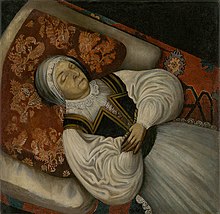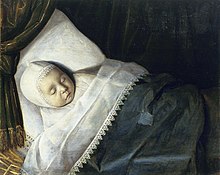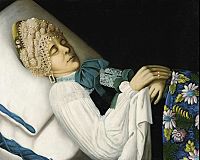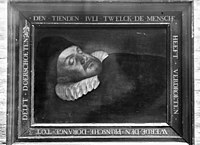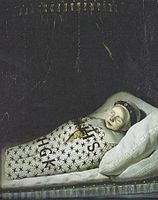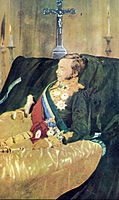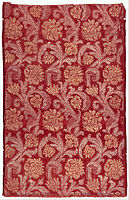88:
73:
231:
114:
136:
20:
175:
28:
246:
155:
50:, displayed for mourners. These were not rare in European homes of well-to-do people as a way of remembering and honoring the dead. People were generally laid out in their best clothes with some sort of special headdress, and some sort of token in their hands. Today these portraits give insights into old funeral customs, but also various types of information regarding folk costumes. In the 19th century
61:
but were never treasured as family heirlooms in the same way as other artworks and thus relatively few early examples such as this one have survived. As a continuous art form, laying out traditions did not go away and photography has continued to preserve the deathbed portrait, though such photos
65:
In the
Netherlands, complicated wreaths of greens were placed around the heads of unmarried people, who were mostly children. In Dutch such a wreath is called a "hoedje" (little hat) and this is part of the general body decoration called "pelen". The word "pelen" is related to the English word
87:
219:
cushion. Her fingers have already discoloured and thread is wrapped around her thumbs. Theoretically, the location is her local church and this is how she looked during the funeral service. She is wearing the costume of the former
Hungarian region of
230:
72:
135:
206:
This painting shows a postmortem portrait of a woman from the
Horvath-Stansith family, K. Horvath-Stansith. She appears to be lying on a bed, but her body has been specially prepared and she is lying not on a bed, but a prepared
113:
174:
161:
154:
245:
19:
57:
Recent research on deathbed portraits, which can be found also in prints and photographs up to today, shows that they became popular after the
308:
126:
350:
66:"pall", as in "pallbearer", which in funeral contexts refers to the cloth (sometimes a flag) over the body or casket.
281:
27:
165:
200:
95:
51:
355:
181:
58:
145:
104:
187:
121:
304:
224:
and the closefitting cap she has on is probably not the headgear she wore when she was alive.
330:
262:
100:
47:
300:
344:
46:
is a portrait of a person who has recently died, usually shown on their deathbed, or
319:
208:
334:
221:
23:
Mourning portrait of K. Horvath-Stansith, née Kiss, artist unknown, 1680s
239:, 1641, by unknown painter, with similar bodice to K. Horvath-Stansith
62:
were meant for mourners and did not find their way into photo albums.
216:
212:
142:
Portrait of a dead child wearing a mourning wreath around its head
26:
18:
303:
exhibition by Bert
Sliggers, Walburg Pers, Zutphen, 1998
199:, a 1680s painting by an anonymous Baroque artist in the
297:
197:Mourning portrait of K. Horvath-Stansith, née Kiss
251:Red damask fragment from the same time period
8:
32:A Child of the Honigh Family on its Deathbed
195:An example of this type of portrait is the
81:, by anonymous 19th-century Russian painter
16:Portrait of a person who has recently died
274:
226:
68:
7:
285:Laying out and "palling" of the body
282:Afleggen en versieren van het lijk
34:, by an unknown painter, 1675-1700
14:
244:
229:
173:
153:
134:
127:Christiaen Jansz van Bieselingen
112:
86:
71:
1:
79:Deathbed portrait of Toropets
372:
54:continued the tradition.
166:Prime Minister of Brazil
237:Unknown Woman of Levoča
215:carpet and special red
201:Slovak National Gallery
52:post-mortem photography
59:Protestant Reformation
35:
24:
168:on his deathbed, 1856
120:Deathbed portrait of
94:Deathbed portrait of
30:
22:
182:Emperor Alexander II
146:Jan Jansz. de Stomme
188:Konstantin Makovsky
351:Portraits of women
122:William the Silent
36:
25:
322:on museum website
320:collection record
162:Marquis of Paraná
44:deathbed portrait
40:mourning portrait
363:
323:
317:
311:
294:
288:
287:on Dutch website
279:
248:
233:
177:
157:
138:
116:
90:
75:
371:
370:
366:
365:
364:
362:
361:
360:
341:
340:
327:
326:
318:
314:
295:
291:
280:
276:
271:
263:Coffin portrait
259:
252:
249:
240:
234:
191:
184:on His Deathbed
178:
169:
158:
149:
139:
130:
117:
108:
105:Berent Hilwaetz
101:King of Denmark
91:
82:
76:
48:lying in repose
17:
12:
11:
5:
369:
367:
359:
358:
353:
343:
342:
339:
338:
331:artwork record
325:
324:
312:
301:Teylers Museum
289:
273:
272:
270:
267:
266:
265:
258:
255:
254:
253:
250:
243:
241:
235:
228:
193:
192:
179:
172:
170:
159:
152:
150:
140:
133:
131:
118:
111:
109:
92:
85:
83:
77:
70:
15:
13:
10:
9:
6:
4:
3:
2:
368:
357:
356:Death customs
354:
352:
349:
348:
346:
336:
332:
329:
328:
321:
316:
313:
310:
309:9789057300424
306:
302:
299:, catalog of
298:
293:
290:
286:
283:
278:
275:
268:
264:
261:
260:
256:
247:
242:
238:
232:
227:
225:
223:
218:
214:
210:
204:
202:
198:
189:
185:
183:
176:
171:
167:
163:
156:
151:
147:
143:
137:
132:
128:
124:
123:
115:
110:
106:
102:
98:
97:
89:
84:
80:
74:
69:
67:
63:
60:
55:
53:
49:
45:
41:
33:
29:
21:
315:
296:
292:
284:
277:
236:
211:laid with a
205:
196:
194:
180:
141:
119:
96:Christian IV
93:
78:
64:
56:
43:
39:
37:
31:
345:Categories
269:References
209:catafalque
335:Europeana
257:See also
190:, 1881
337:website
307:
222:Levoča
217:damask
148:, 1654
129:, 1584
107:, 1650
213:Kilim
186:, by
144:, by
125:, by
103:, by
305:ISBN
160:The
333:on
42:or
347::
203:.
164:,
99:,
38:A
Text is available under the Creative Commons Attribution-ShareAlike License. Additional terms may apply.
